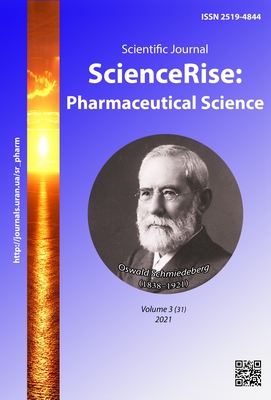Experimental substantiation of the composition of the gel base with hydrocortisone for use in veterinary medicine
DOI:
https://doi.org/10.15587/2519-4852.2021.233664Keywords:
gelling agent, Aristoflex, hydrocortisone, composition, technology, rheological studies, atopic dermatitis, veterinaryAbstract
As veterinary practice shows, most often atopic dermatitis in animals manifests itself in the form of a rash (in the ears, muzzle, paws, etc.), which in turn is accompanied by itching. First of all, prescribe a single injection of glucocorticoids, or short-term therapy. Corticosteroid hormones (glucocorticoids) are one of the most powerful antiallergic drugs. They are effective in treating almost all types of allergic reactions. An appropriate dose of glucocorticoids is required to obtain a rapid effect, and the form of the drug should be convenient to use.
The aim of the research. The aim of our study was experimentally substantiate the choice of the optimal gelling agent when developing a gel composition with hydrocortisone for use in veterinary medicine.
Materials and methods. Physical, physico-chemical and pharmaco-technological methods were used during the experimental study. Studies were performed according to the method described in the SPhU. The rheological properties of the samples were determined using a rotary viscometer type Brookfield HB DV (USA) with spindle SC4-21.
Results. As a result of the research, it was found that Aristoflex as a gelling agent in the development of a veterinary drug of local action will ensure the availability of appropriate extrusion properties (namely, easy and uniform application of animal skin, ease of use). Gels with hydrocortisone based on Aristoflex gave stable performance, which was confirmed by the results of mechanical and colloidal stability.
Conclusions. The composition and technology of a hydrocortisone gel for local therapy of atopic dermatitis in animals has been developed. Aristoflex at a concentration of 1.5 % on the basis of a set of physicochemical, structural-mechanical and biopharmaceutical studies was selected as the optimal gelling agent in the drug
References
- Bajwa, J. (2016). Atopic dermatitis in cats. The Canadian Veterinary Journal, 59 (3), 311–313.
- Hensel, P., Santoro, D., Favrot, C., Hill, P., Griffin, C. (2015) Canine atopic dermatitis: detailed guidelines for diagnosis and allergen identification. BMC Veterinary Research. 11 (196), 46–54. doi: http://doi.org/10.1186/s12917-015-0515-5
- Marsella, R., Segarra, S., Ahrens, K., Alonso, C., Ferrer, L. (2020). Topical treatment with SPHINGOLIPIDS and GLYCOSAMINOGLYCANS for canine atopic dermatitis. BMC Veterinary Research, 16 (1). doi: http://doi.org/10.1186/s12917-020-02306-6
- Santoro, D. (2019). Therapies in Canine Atopic Dermatitis: An Update. Veterinary Clinics of North America: Small Animal Practice, 49 (1), 9–26. doi: http://doi.org/10.1016/j.cvsm.2018.08.002
- Fridman-Bengtsson, O., Höybye, C., Porthén, L., Stjärne, P., Hulting, A.-L., Sunnergren, O. (2019). Evaluation of different hydrocortisone treatment strategies in transsphenoidal pituitary surgery. Acta Neurochirurgica, 161 (8), 1715–1721. doi: http://doi.org/10.1007/s00701-019-03885-6
- Mueller, R. S. (2019). Update on Allergen Immunotherapy. Veterinary Clinics of North America: Small Animal Practice, 49 (1), 1–7. doi: http://doi.org/10.1016/j.cvsm.2018.08.001
- Ibrahim, F., El-Deen, A. K., Shimizu, K. (2018). Comparative study of two different chromatographic approaches for quantitation of hydrocortisone acetate and pramoxine hydrochloride in presence of their impurities. Journal of Food and Drug Analysis, 26 (3), 1160–1170. doi: http://doi.org/10.1016/j.jfda.2017.12.008
- Folster-Holst, R., Abeck, D., Torrelo, A. (2016). Topical hydrocortisone 17-butyrate 21-propionate in the treatment of inflammatory skin diseases: pharmacological data, clinical efficacy, safety and calculation of the therapeutic index. Pharmazie, 71 (3), 115–121.
- Kligman, A. M., Kaidbey, K. H. (1978). Hydrocortisone revisited. An historical and experimental evaluation. Cuties, 22 (2), 232–244.
- Bruet, V., Bourdeau, P. J., Roussel, A., Imparato, L., Desfontis, J.-C. (2012). Characterization of pruritus in canine atopic dermatitis, flea bite hypersensitivity and flea infestation and its role in diagnosis. Veterinary Dermatology, 23 (6), 487–493. doi: http://doi.org/10.1111/j.1365-3164.2012.01092.x
- Favrot, C., Steffan, J., Seewald, W., Picco, F. (2010). A prospective study on the clinical features of chronic canine atopic dermatitis and its diagnosis. Veterinary Dermatology, 21 (1), 23–31. doi: http://doi.org/10.1111/j.1365-3164.2009.00758.x
- Miller, W. H., Griffin, C. E. (2013). Small animal dermatology. St. Louis: W.B. Elsevier, 24 (3), 57–107.
- Olivry, T., DeBoer, D. J., Prélaud, P., Bensignor, E. (2007). Food for thought: pondering the relationship between canine atopic dermatitis and cutaneous adverse food reactions. Veterinary Dermatology, 18 (6), 390–391. doi: http://doi.org/10.1111/j.1365-3164.2007.00625.x
- Lourenço, A. M., Schmidt, V., São Braz, B., Nóbrega, D., Nunes, T., Duarte‐Correia, J. H. et. al. (2016). Efficacy of proactive long‐term maintenance therapy of canine atopic dermatitis with 0.0584 % hydrocortisone aceponate spray: a double‐blind placebo controlled pilot study. Veterinary Dermatology, 27 (2), 88. doi: http://doi.org/10.1111/vde.12285
- Yarnykh, T. G., Tykhonov, O. I., Melnyk, G. M., Yuryeva, G. B. (2017). Pharmacopoeian aspects of suspensions preparation in pharmacy conditions. Asian Journal of Pharmaceutics, 11 (4), 859–864.
- Rukhmakova, O. A., Yarnykh, T. G., Pul-Luzan, V. V., Kotenko, O. M., Buryak, M. V. (2020). Experimental research on the development of extemporaneous ointment for the treatment of proctologic diseases. Journal of Global Pharma technology, 12 (1), 229–234.
Downloads
Published
How to Cite
Issue
Section
License
Copyright (c) 2021 Viktoriia Pul-Luzan, Olga Rukhmakova

This work is licensed under a Creative Commons Attribution 4.0 International License.
Our journal abides by the Creative Commons CC BY copyright rights and permissions for open access journals.








